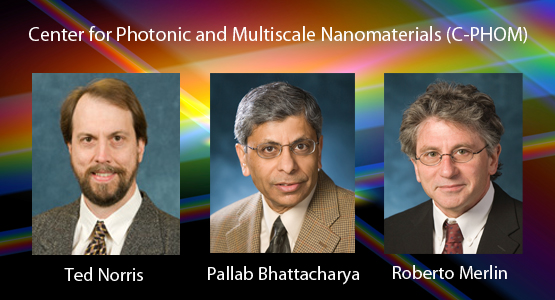New NSF Center for Photonic and Multiscale Nanomaterials
“Advances in photonics depend critically on new materials, and this new center brings together top minds to focus on two of the most exciting new directions in materials for nanophotonics.”

 Enlarge
Enlarge
ANN ARBOR, Mich. – A new $13-million National Science Foundation center based at the University of Michigan will develop high-tech materials that manipulate light in new ways. The research could enable advances such as invisibility cloaks, nanoscale lasers, high-efficiency lighting, and quantum computers.
The Center for Photonic and Multiscale Nanomaterials, dubbed C-PHOM, involves engineering and physics researchers from the U-M College of Engineering and the College of Literature, Science and the Arts, as well as close collaborators at Purdue University and several other institutions.
Photonics is the study and use of light to transmit and store information, as well as to image things humans can’t see with unaided eyes. It’s one of the key technologies underlying modern life, says Ted Norris, director of the new center and a U-M professor in the Department of Electrical Engineering and Computer Science.
Photonics provides the high-speed backbone of the Internet through fiber optics. It serves as a ubiquitous tool for medical imaging. And it enables the study of the most exotic ideas in quantum physics, such as entanglement and quantum computing.
“Advances in photonics depend critically on new materials, and this new center brings together top minds in electrical engineering, materials science, and physics to focus on two of the most exciting new directions in materials for nanophotonics,” Norris said. “The cross-campus collaboration will enable fundamental advances.”
The center has two thrusts. One group will focus on improving “wide bandgap semiconductors” such as gallium nitride, which could make possible quantum emitters that release one photon, or light particle, at a time and could advance quantum computing and quantum information processing.
Quantum computers could vastly improve computer security. Because they could theoretically factor numbers dramatically faster than conventional computers, they could allow for the creation of foolproof security codes. This research thrust also has applications in high-efficiency lighting and imaging. Leading this group is Pallab Bhattacharya, the Charles M. Vest Distinguished University Professor, and a professor in the U-M Department of Electrical Engineering and Computer Science.
A second group of researchers will develop better metamaterials, uniquely engineered mixtures of substances that enable scientists to make light act in ways it does not behave in nature. For example, metamaterials make it possible to focus light to a speck smaller than its wavelength, They could potentially be used to bend light around objects, making them invisible. They could also bring about “ultra subwavelength imaging” to see inside biological cells with unprecedented resolution. Leading this group is Roberto Merlin, the Peter A. Franken Collegiate Professor of Physics at U-M. His team will work in close collaboration with researchers at Purdue.
Other institutions involved in the new center are: Wayne State University, the City University of New York’s Queens College, the University of Texas at Austin, the University of Illinois at Urbana-Champagne, and Argonne and Sandia National Laboratories.

 Enlarge
Enlarge

 Enlarge
Enlarge

 MENU
MENU